Are you familiar with Trebizond silk? When it comes to silk threads, Trebizond is Pure Luxury. I don’t think Trebizond has quite come into its own yet, in the surface embroidery world. Here and there, you hear about it used in surface embroidery, but mostly, it seems to more popular in needlepoint or canvas work.
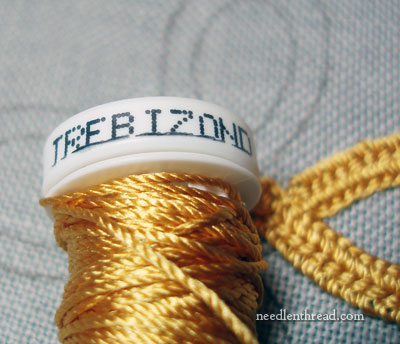
Trebizond is a relatively thick, 3-ply twisted filament silk. It has a marvelous sheen that only comes with filament silk, and it is so very soft and sumptuous. Truly, it is a Gorgeous Thread.
It’s z-twisted, so in some cases, the approach to using it has to be different. Certain stitches (especially stitches that twist together, like stem stitch) have to be worked opposite to normal. You can read more about z-twist vs. s-twist threads here, and about stem stitch with z-twist threads here, to see what I’m talking about, if you’re not familiar with the topic.
While Trebizond is a beautiful thread and I think every embroiderer should use it at least once at some point, I’d say Trebizond is not for the beginner-in-silk. If you’re just beginning to stitch with silk, a stranded silk like Soie d’Alger is a better bet for starting out.
But, anyway, why Trebizond? Why now? And with what?
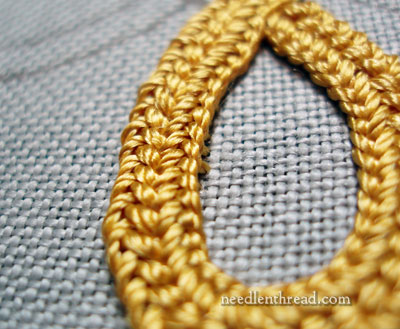
This is a spontaneous project. Call it a challenge, if you like. It came about through an e-mail several weeks ago, and it’s been stewing in the back of my head ever since.
The e-mail was from a reader who was looking for a recommendation for a silk thread to use with the plaited braid stitch.
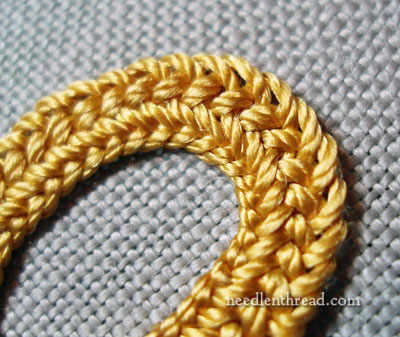
She had consulted someone familiar with the plaited braid stitch with the same question and was told that it “should only be done with metal thread,” but wasn’t really given any reason, just a list of recommended metal threads.
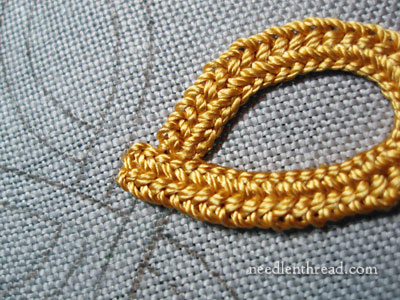
What does that mean, it “should only” be done with metal thread?
This notion surprised me a bit, and it got me thinking (which can often be a dangerous pastime). There are two things about this Should-Only that bug me:
First, there’s the notion that certain stitches were developed exclusively for use with certain threads. So, apparently, for all eternity, this stitch and that thread must be married together, and no one must tear them asunder? Ever? This approach would hardly advance the cause of any art.
Second, there’s this idea that somewhere out there, lurking around, just waiting, are the Embroidery Police. And if you stray from what “should only” be done, you’re going to get your needles revoked.
“Should-onlies” don’t quite fit in the world of hand embroidery! See, there’s usually more than one way to do just about anything related to hand embroidery, whether it’s how to work a stitch, how to transfer a design, which threads to combine with which, and on and on and on. Sometimes, it’s true, there are easier ways, or more efficient ways, or more logical ways to accomplish embroidery-related tasks, and it makes sense to learn those ways. But very rarely is there only one way.
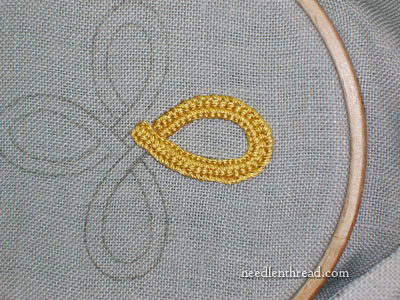
Because of the structure of plaited braid stitch and the tensioning involved in the stitch to get it to look right, it’s true that many consider it “easier” to work the stitch with a metal or metallic thread, or some kind of cord, or something with a bit of stiffness to it.
And it’s true that many of the images of plaited braid that we see today feature plaited braid stitch worked in some re-creative historical context, in metal threads.
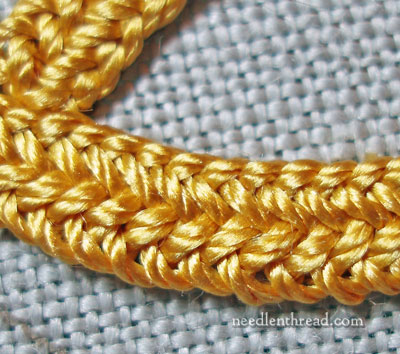
But it’s also true that plaited braid stitch looks darned terrific worked with Trebizond. It’s also true that plaited braid stitch really isn’t that difficult to work in a non-metal thread.
And I think it’s also true that if we only slavishly re-create historical items without adding our own unique touches, approaches, techniques, interpretations, and so forth, then we haven’t actually brought anything new to the art of embroidery. We haven’t advanced the art any, have we?
It’s very important to learn from the past, but it’s also important to bring something new to what we learn. That is how art advances.
I picked Trebizond to establish the Plaited-Braid-in-Silk Point for two reasons: 1. It’s a nice thick thread, and plaited braid looks good with a thicker thread rather than a skimpy thread; 2. Trebizond has a reputation for being somewhat fiddly, which increases the challenge of working the stitch with this thread, and I liked the increased challenge. You could also work the stitch with a stranded silk (like Soie d’Alger), using all the strands in one thread.
But one point you might note, before you launch into your next project that you’re covering with plaited braid stitch worked with silk. The stitch is a Thread Hog Extraordinaire. If you ever want a stitch that eats thread like a whale eats plankton, this is it! So keep that in mind. You might practice it first with cotton to gauge how much thread it uses for you, and then determine how much silk you’ll need.
If you’re keen to try Trebizond, you can find it at Nordic Needle, at Threadneedle Street, at Needle in a Haystack, and at Fireside Stitchery. The last two shops are a bit more expensive than the first shops listed, so check prices before purchasing!







Dear Mary
Interesting thread a couple of questions when you say it’s a 3 ply can you split the thread. Can it be used on a high count linen with a thin backing or is it to thick for that. I would love to try it!!!
Thanks Mary
Regards Anita Simmance
Hi, Anita! Normally, Trebizond is used all three plies at a time. It’s a 3-ply, non-divisible thread, similar in that way to perle cotton. But you can actually take the 3 plies apart, at which point, you’d treat them like a flat silk, though they are wavy when taken apart. You can satin stitch small spans with them, for a very pretty, wavy effect. You can use Trebizond on a high count linen, but make sure the needle you use is large enough to make it easy for the thread to pass through the fabric. With Trebizond, I find that a slower pace with stitching is also helpful – pull through slowly, not fast. If you rip the thread through the fabric very quickly, the thread twists up.
It really is a lovely thread!
~MC
It’s beautiful, Mary!
Hi Mary!
What a beautiful thread! I’ve only ever worked with cotton, but would love to try silk someday! Do you have a tutorial for plaited braid stitch? I looked in your videos and can’t find it. Thanks,
Alyssa
I’m looking for(ward to?) that plaited braid stitch video as well! Thanks in advance, Mary…I guess this post is a taste of things to come – and I can see you’re working on it! As to the ‘should onlies’…they should only learn to let go, make do and enjoy!
Hi, Elisabeth – Yes, you’re right. Upcoming stuff, slowly but surely! I’m feeling very much like the tortoise, though wishing I were more like the hare. But in the long run…! ~MC
Soon, Alyssa, soon! I’ve got quite a few things in the works at the moment, including that! ~MC
Mary,
I have used Trebizond quite a bit in the last couple years. These were “as is” and separated applications. I found with the separated ply, I used a completely different tension and a laying technique similar to that of flat silk. I have even found myself damping the thread as if it were a rayon. Sometimes I tear a thread down to its smallest component because I want the color, or to blend it with something else. I’ve even split eterna….
Hi, Kimberly – yes, that’s true – if you slightly dampen it, you can use the separated plies just like flat silk. If you don’t dampen it, you can use them like flat silk, but they will be wavy. It’s so pretty, isn’t it? Breaking it down into smaller “suga” (individual filaments) is a good way to get tiny delicate threads for little things like eyes. It’s a versatile thread! ~MC
Excellent points!!! You are so good, Mary!! I, too, think Trebizond is an amazing thread. One of my favorite things to do with it is a close coral stitch line — and it ends up looking like a row of shiny silk pearl beads all lined up.
Nummy, that silk looks good enough to eat! No matter how many irons I have in the fire, Mary, you always make me want to shove them over to make room for one more!
Dare we hope your experiments are a prelude to doing a how-to video for the plaited braid stitch? Please, please, please !
And, if I may, Mary, for Canadians this thread can be found at Stitcher’s Muse in Naniamo.
http://thestitchersmuse.com/ I’ve no affiliation. Rather I just discovered it and it’s loaded with good stuff.
Hi Mary,
I tried the links in the earlier blogs on this stitch but found that Leon Conrad’s web site is no longer available, and alas, all the pictures on this stitch at Pilmoth Plantation cannot be seen.
I’ll try to get Jacqui Carey’s Elizabethan’s Stitch, but you know what they say, a “video” is more than a thousand words! I hope you will do a video on this beautiful but elusive stitch soon!
I have used this thread in needlepoint projects. I love the the results but found working with it a bit sticky. I have dry skin and when I stitch a lot i build up rough spots on my fingers from the needle. Any little bump on your stitching fingers will cause the thread to snag. If I’m stitching with this thread I cut the fingers off surgical gloves and wear them on my thumb, index and middle finger so it is easier to work with.
Dear Mary,
Very interesting stitch!!!!
It look so rich in the yellow.
Is this the same stitch as the “Braid Stitch” in your “How to videos”.
I surely want to try this one.
Thanks for a wonderful blog!!!!!
Alet
Ok, you’ve sold me on this gorgeous thread. Can’t wait to try it. Nordic Needle says it’s about the size of #5 pearl cotton. What size and type needle would be best to use for it on linen? And what count linen did you use in that test sample? Looks very nice for use on vestment designs….. got to get me a selection of “golds” and other liturgical colors to use. I’ve been using pearl cottons in various sizes, but this silk is a real step up to that.
Tess
Mary, that look fabulous. I confess I haven’t yet used Trebizond mainly because for the most part I don’t like thick threads and avoid perle 3 like the plague. But I have just reread Jacqui Carey’s Elizabethan Stitches and realised that in fact I need thick threads for most of the stitches. And since I gave up on the idea of practicing with a ‘student’ or lesser quality material many years ago, it’s beginning to look as though I will have to buy some Trebizond and start practicing. I may wait until you do a demo video for us though, it makes thing like this much easier.
Thank you so much for your wonderful instructions.
Hi All:
Well, you’ve definitely sold me on the Trebizond thread which I will be trying without delay. However, I didn’t know there were onlies with the plaited braid or other Elizabethan stitches as I taught myself plaited braid with perle thread and am working on learning other Elizabethan stitches in Carey’s new book also with perle.
I try them with the good metal thread only after I have some mastery. And blasphemy, I have incorporated plaited braid as a border on other work also in the perle. It works very nicely as a learning thread for those difficult stitches.
Anastasia
I recently bought a kit that uses Trebizond silk for satin stitches around other needlepoint stitches and I am stymied on how to end the stitching so it will not come undone. I’m using 25 count linen and the stitches seem rather loose so just running the end under the satin stitches doesn’t seem adequate. I do love the silk and got on your website to see how to use it.
I love your website! I happened onto it awhile back when looking up how to do a stitch. There it was and how excited i was to share the news!
So , if you have some advise on that I surely would appreciate it. God Bless. Jean
Hi, Jean – Is it possible to make little anchoring stab stitches in an adjacent area, that will be stitched over? That’s a good way to anchor pretty much any thread. I’m concerned, though, that you say your stitches are loose….! One trick to tightening a stitch is to give the thread a little tug after starting the next stitch – so, you take your needle down to the back to end stitch 1. This isn’t where you tighten the stitch – instead, when you bring your needle to the front for stitch 2, you give the thread a little tug to tighten stitch 1, and the tension should remain. The stitch shouldn’t loosen up again. Of course, you don’t want your stitches too tight – but you don’t want them loose, either!
Do u teach classes if so where. I would like to attend.
Hi, Alesia – I don’t have any classes on offer at this time, I’m afraid. But thanks for asking!
WOW! A perfect thread for a perfect stitch and perfect work.
Very impressed!